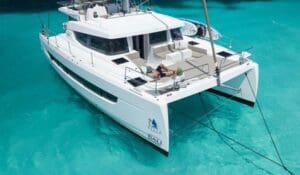 Stephen and I have made numerous ocean passages, some lasting only a few days and others several weeks at a time. The longest passage that we have done is from Cape Town, South Africa via St. Helena Island to Fortaleza, South America and then Miami. It was a total of 42 days at sea. It took some real planning on our part. Not only did we have to plan the usual things like navigation, provisions, fuel etc. but we were also actively working while we were doing the crossing, so we needed to have good communication. We used a software called OCENS with our Iridium Satelite phone to send and receive email and for making calls, as well as getting the weather forecast. That was back in 2005, today it is much easier and cheaper to do. As we all know, good ocean passage making preparations are crucial for success and safety. Stephen and I, each have our own dedicated areas of responsibility to prepare the boat and the crew. That way we know what is expected of each crew member and there is no confusion about who did what. We then double check to make sure all items have been taken care of before we cast off.
Stephen and I have made numerous ocean passages, some lasting only a few days and others several weeks at a time. The longest passage that we have done is from Cape Town, South Africa via St. Helena Island to Fortaleza, South America and then Miami. It was a total of 42 days at sea. It took some real planning on our part. Not only did we have to plan the usual things like navigation, provisions, fuel etc. but we were also actively working while we were doing the crossing, so we needed to have good communication. We used a software called OCENS with our Iridium Satelite phone to send and receive email and for making calls, as well as getting the weather forecast. That was back in 2005, today it is much easier and cheaper to do. As we all know, good ocean passage making preparations are crucial for success and safety. Stephen and I, each have our own dedicated areas of responsibility to prepare the boat and the crew. That way we know what is expected of each crew member and there is no confusion about who did what. We then double check to make sure all items have been taken care of before we cast off.
1. Plan Your Passage
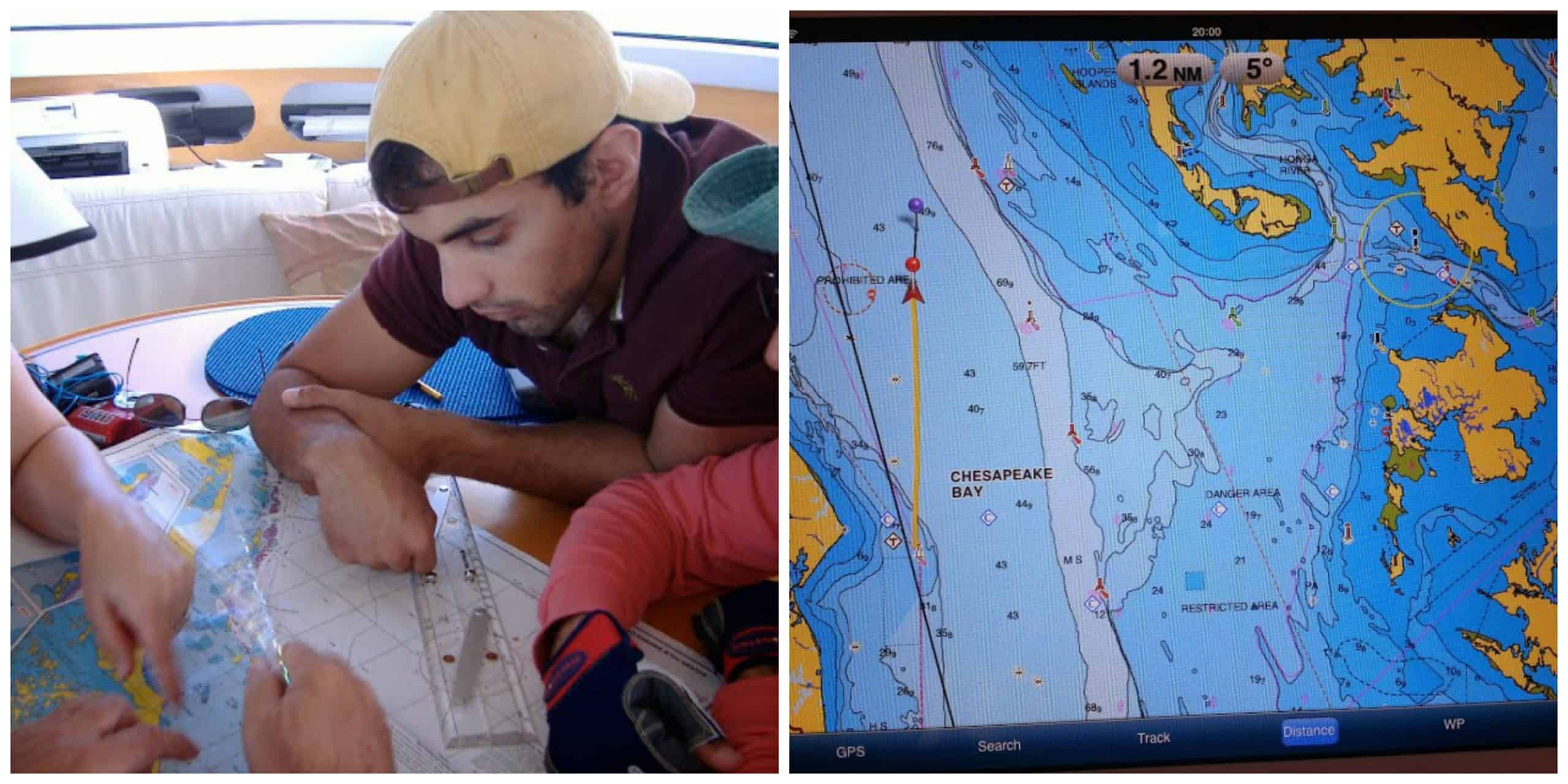 We study the prevailing weather patterns for the region for the time of year we plan to make the passage. Based on that information we will pick an approximate date to set off. About two weeks out, we will start watching the weather. For our passage at the end of April from Fort Lauderdale to the Chesapeake Bay, we used passageweather.com and windguru.cz to plan our route and date of departure, subject to change at any moment of course. Both these sites are great and fairly accurate and give one the predicted wind direction and speed, swell direction and height as well as precipitation, 7 days out. It also shows where the Gulfstream flows the fastest north so one can plan a route accordingly. The Gulfstream flows north and can push up to 3.5 knots in places so it is a great help when going north, however watch out going south! Also, any northerly component in the wind direction makes the Gulfstream untenable, so we were particularly careful about leaving with mostly southerlies or in that range. When doing long passages try the different weather forecasting and routing services on SSB and other radio nets (see resources below).
We study the prevailing weather patterns for the region for the time of year we plan to make the passage. Based on that information we will pick an approximate date to set off. About two weeks out, we will start watching the weather. For our passage at the end of April from Fort Lauderdale to the Chesapeake Bay, we used passageweather.com and windguru.cz to plan our route and date of departure, subject to change at any moment of course. Both these sites are great and fairly accurate and give one the predicted wind direction and speed, swell direction and height as well as precipitation, 7 days out. It also shows where the Gulfstream flows the fastest north so one can plan a route accordingly. The Gulfstream flows north and can push up to 3.5 knots in places so it is a great help when going north, however watch out going south! Also, any northerly component in the wind direction makes the Gulfstream untenable, so we were particularly careful about leaving with mostly southerlies or in that range. When doing long passages try the different weather forecasting and routing services on SSB and other radio nets (see resources below).
2. Wait For A Weather Window
The basic rule we use to avoid trouble is to wait for a weather window for the upcoming passage. Usually we wait for light conditions to ease into a trip (Estelle usually feels a little queasy the first day out), other times we leave on the tail of a weather system that will help us along for a day or so. The general rule is that most forecasts today are fairly accurate for 3-5 days. Beyond that it is unpredictable and one should plan for unexpected conditions. We have learned over the years that setting a specific date for departure or having a schedule getting to places is complete folly. Leaving in adverse conditions to meet a deadline is asking for trouble.
3. Offshore Checklist
 We started this sailing season with our annual haulout during which we serviced the saildrives, engines, ground tackle, steering system, running and standing rigging, charging system, navigation lights, and sails etc.
We started this sailing season with our annual haulout during which we serviced the saildrives, engines, ground tackle, steering system, running and standing rigging, charging system, navigation lights, and sails etc.
4. Check And Test Emergency Gear
Renew EPIRB with updated information with NOAA. Check that MOB strobe light batteries are good and flares are in date. Make sure that the MOB horseshoe ring and lifesling is attached properly, life jackets and harnesses are easily accessible and that all crewmembers know where they are stowed. Make sure that your life raft is in date and easily accessible and that every crewmember knows how to operate it. Check your ditchbag and medical kit and replenish or replace supplies. Again, make sure it is easily accessible and that the crew knows where it is stowed. Make sure that your crew knows how to do a crash stop and what to do to retrieve a man overboard.
5. Navigation Gear
Test the VHF and have at least one hand held VHF for emergencies. Check that the autopilot functions well and if possible, carry a spare. Radar is good to have, specially if you plan to sail in areas with heavy fog or busy shipping channels and it is invaluable for tracking squalls. Make sure your GPS functions correctly and have a spare handheld just in case. ALWAYS have paper charts in case all electronics fail and log the trip in your ship’s log. We used our iPads for navigation and plotted ourselves every 6 hours on the paper chart. We particularly liked the BoatBeacon App on the iPad that functions as an AIS Marine navigation system, tracking shipping traffic on the Cheaspeake Bay.
6. Provisioning
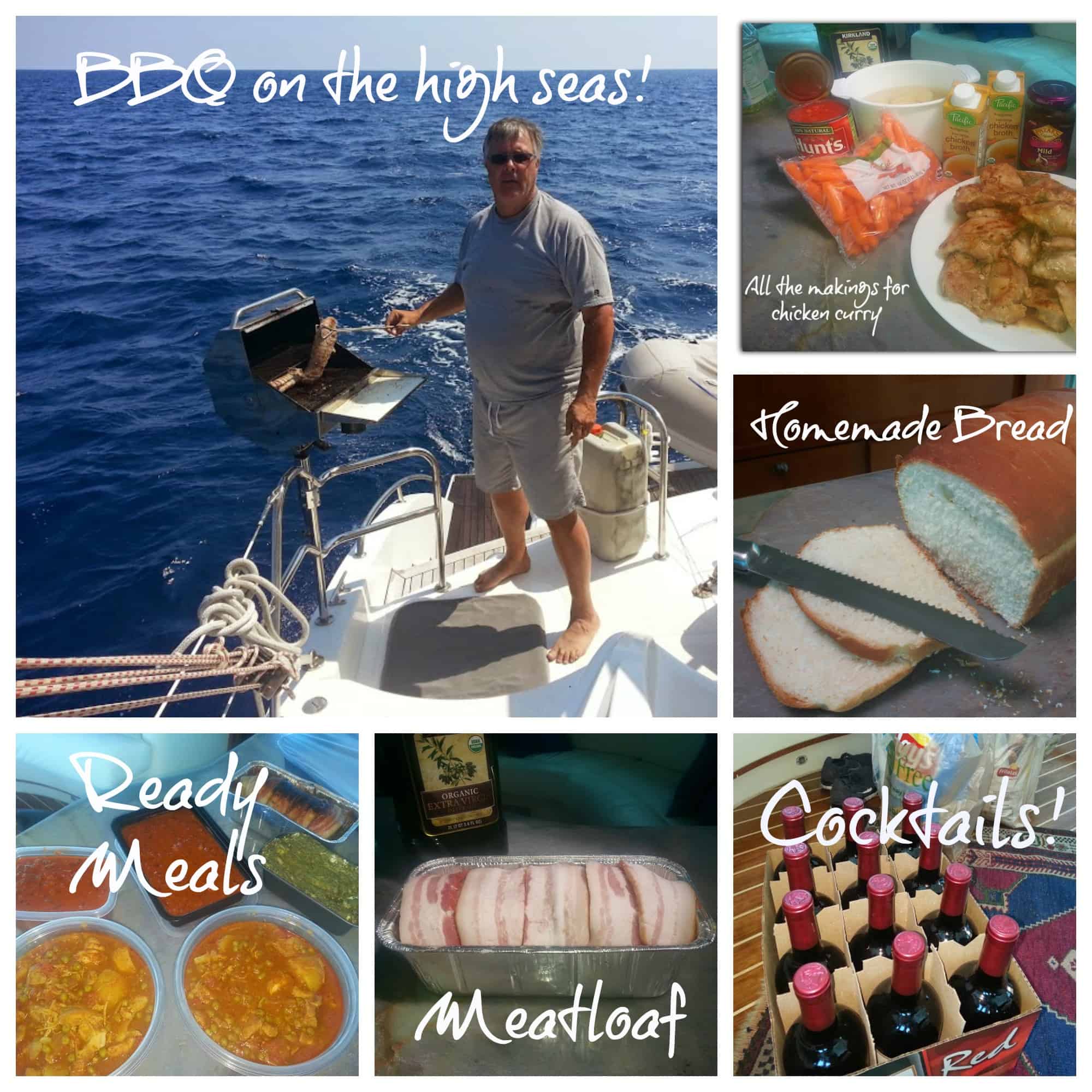
Make sure that the crew is properly fed. It is good for morale and makes for a happy environment on board. Make up an informal menu for the approximate number of days on passage and add 20% plus some emergency food items like canned tuna, chicken, corned beef, and beans or whatever you prefer, we like protein. In dire situations, if all goes wrong on board, one can easily eat these items cold and from the can if need be. Also stock up on some protein bars. Make an inventory of food aleady on board and add ingredients on the menu to shop for. I usually purchase the dry goods on the menu first and stow. The day before we leave, I get the perishable items. This makes for a less overwhelming task. Organize galley lockers or pantry with food items to be used on the passage in easily reachable places to minimize looking for ingredients all over the boat. I usually buy tomatoes, avocado, pineapple, mangoes, and bananas as green as possible to ripen over time. Potatoes and onions get stowed in a dark dry place. Oranges, lemons, apples, cabbage, carrots, squash, and other hearty veggies last a long time and mostly do not need refrigeration. So I buy a fair amount of those instead of things highly perishable foods like lettuce. We like eggs for breakfast so I buy fresh eggs and eggbeaters to make scrambled egg or omelets. I usually plan simple, easy-to-prepare meals for our passages, especially for the first few days out. Before casting off, I prep at least three simple, but satisfying meals (chicken curry, meatloaf, shepard’s pie, Bolognese) then freeze them for bad weather days. I always have a few steaks in the freezer for a nice day when we can BBQ off the back of the boat when there is not freshly caught fish. We like to make sashimi or grill the fish straight away. If conditions are good, I will bake bread every 3-4 days. We tend to snack during night watches, so I bake cookies before we leave and have some candy bars stowed away. Check out the Boatgalley.com for more provisioning tips or contact me for comprehensive provisioning planning.
7. Fishing Gear
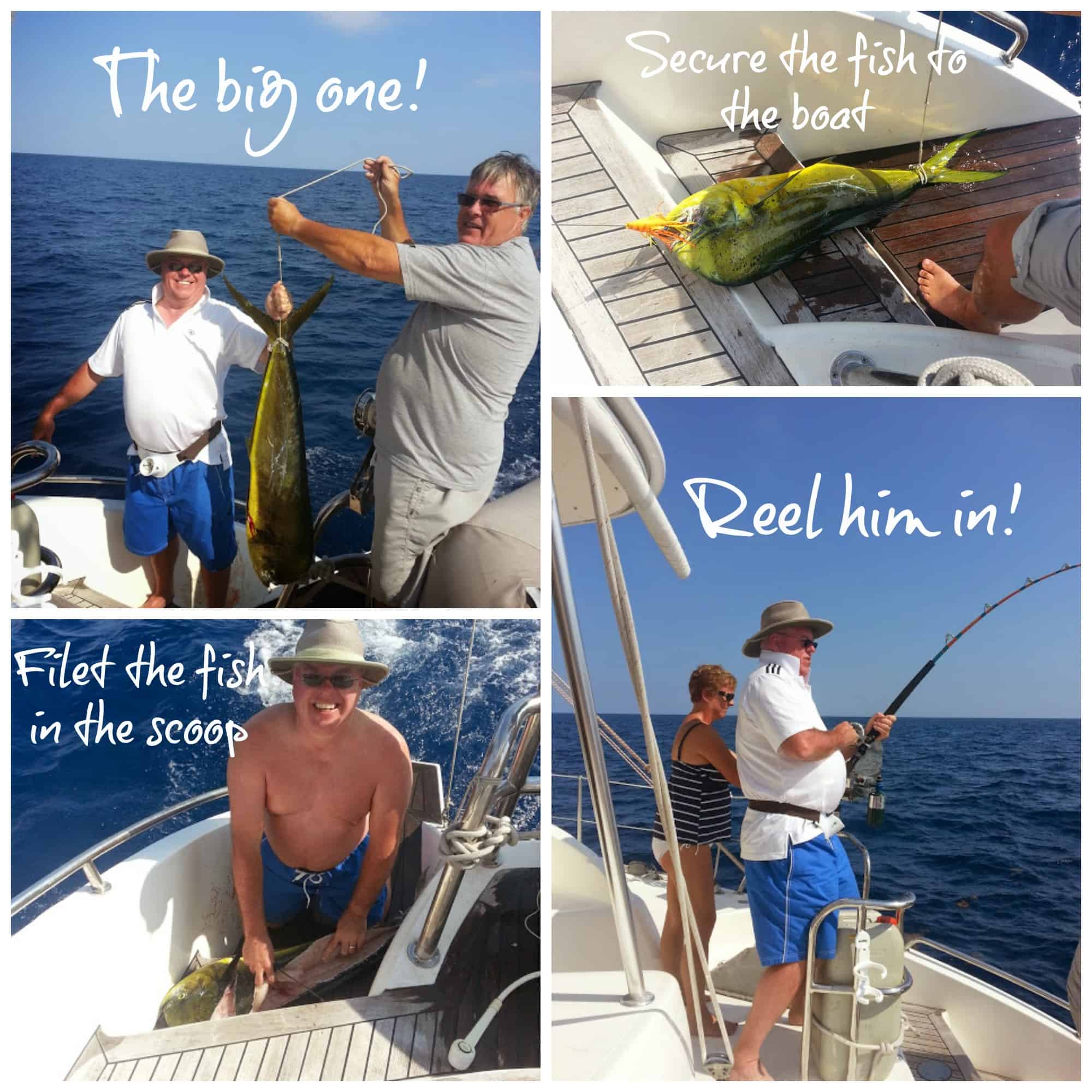 We like to catch fish while doing passages. It makes for some excitement on board and boy, there’s nothing better that cooking some fresh fish on the BBQ while underway. Stephen usually has one rod and reel as well as a hand line and several lures and hooks and extra fishing line in case we get spooled. Be ready with your alcohol in a spraybottle to spray in the gills of the fish! It subdues the fish instantly and makes the catch less messy. We have a super sharp fish filet knife and we usually fillet the fish right in the scoop, wash and package the fish before it goes anywhere near the inside of the boat and get rid of the carcass off the back. Lines up! We only catch what we can eat!
We like to catch fish while doing passages. It makes for some excitement on board and boy, there’s nothing better that cooking some fresh fish on the BBQ while underway. Stephen usually has one rod and reel as well as a hand line and several lures and hooks and extra fishing line in case we get spooled. Be ready with your alcohol in a spraybottle to spray in the gills of the fish! It subdues the fish instantly and makes the catch less messy. We have a super sharp fish filet knife and we usually fillet the fish right in the scoop, wash and package the fish before it goes anywhere near the inside of the boat and get rid of the carcass off the back. Lines up! We only catch what we can eat!
8. Watch Keeping
Our watch keeping system is simple. We ALWAYS have someone on watch but since we rely on the autopilot to steer the boat, we only have to watch for ships, obstructions, make log entries, and check our sails occasionally. We do not rotate our watches because our bodies adjust better to watches if we do the same ones every night. When it is only the two of us, we do three hours on and three hours off but we make it shorter with more crew so that we get some decent rest in between watches. During the day it’s sort of a loose system with one or the other or both on watch while we tend to our chores like cooking, navigation, cleaning, etc. Stephen usually makes the rounds on deck inspecting for chafe etc. during the day. In particularly bad weather, we will do 1hour watches if the autopilot labors too hard and we are required to hand steer. Stephen’s method of using an egg timer seems to work really well for night time watches. He sets the timer for 14 minutes at which time he gets up, checks for lights and generally makes sure that everything is as it should be for about 3 minutes and goes back to reading or taking a nap. It helps break up the time and after a night or two, your body gets used to the routine.
9. Water Management
 Fill water tanks – check and double check. We BOTH make sure that this task is done before we leave and check that all faucets are closed and have no leaks. We NEVER leave this task to anyone else. This could be life or death! We also isolate one tank of water for emergencies only and have at least 4 jerry cans (20 gallons) of water spare. Today, with a lot of boats fitted with watermakers, it is much easier to manage this resource but even so, we are always careful. We shower daily in seawater off the back of the boat (if conditions allow) and have a quick rinse in fresh water. If we will be at sea for more than a week, we each get one gallon of fresh water per person per day for showers and cleaning. Drink as much as you need.
Fill water tanks – check and double check. We BOTH make sure that this task is done before we leave and check that all faucets are closed and have no leaks. We NEVER leave this task to anyone else. This could be life or death! We also isolate one tank of water for emergencies only and have at least 4 jerry cans (20 gallons) of water spare. Today, with a lot of boats fitted with watermakers, it is much easier to manage this resource but even so, we are always careful. We shower daily in seawater off the back of the boat (if conditions allow) and have a quick rinse in fresh water. If we will be at sea for more than a week, we each get one gallon of fresh water per person per day for showers and cleaning. Drink as much as you need.
10. Fuel and Batteries
We have had to have our tanks cleaned out and fuel polished this season after we detected some nasty critters and water in the fuel filters. This can become a real issue so make sure that your fuel is as clean as possible. Fill fuel tanks and manage this resource. Figure out what distance you can motor (we do under a gallon per hour per engine and we run only one engine at a time) and make sure that you conserve enough fuel to motor into a harbor or motor yourself out of a sticky situation. Running the tanks dry will lead to having to bleed the fuel system, not a difficult thing to do but very unpleasant at sea. We usually have emergency fuel in jerry cans in case we motor more than expected and we run out. Make sure that you carry spare impellers, fan belts and fuel filters and know how to change them, usually a fairly simple procedure. It is advisable that you do an engine course to understand the basics about your engine. Manage your charging system diligently. We use approximately 15-20 amps per hour with the autopilot, fridge / freezer, lights and other stuff. We usually charge our catamaran’s house batteries 2 hours per day (by generator as it uses less fuel) and have solar panels that will give us a further 60-80 amps per day, unless overcast. That seems to keep us going pretty well but we are always very careful not to waste this resource.
Read about our multi-source power management planning whichincludes how we kitted Zuri‘s successor, Z3, a Bali 5.4 for her Atlantic crossing.
Weather and Communication ResourcesPassage Weather: Free worldwide 7-day Wind, Wave and Weather Forecasts. Weather Underground: Gulfstream weather NOAA Climate Prediction Center Windguru: Global wind speed, direction, wave height, direction, cloud cover and rain. Buoyweather: Provides 7 day text forecasts, passage outlooks, weather charts anywhere on earth. Marine Weather Center: Daily Email Forecast, Weather Routing. Noonsite Weather & Routing Forum Cruising Radio Nets: Weather routing and forecasts for cruisers. |
Check out our Photo slideshow and Ocean Passage Video below.
Read the Trip Report from the crew onboard Lagoon 450S catamaran Zuri on our offshore ocean passage.
Contact us for more indepth information or leave a comment with your tips on ocean passage making.
Sail With Us to Learn

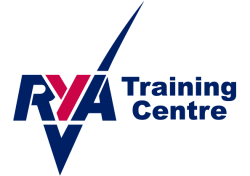
Week-Long Liveaboard Courses
Rare RYA Classes & Certifications
Catamaran Guru’s real-life practical methods combined with up-to-date sailing theory in lessons aboard recent model catamarans…or your own boat!
Prepare for certifications or take the first step aboard to embark on your dream life of boat ownership or cruising
Classes in S Florida and the Bahamas.




